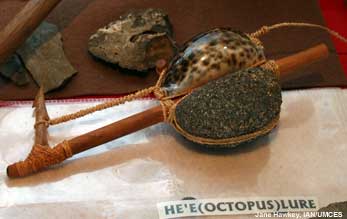 To traditionally catch a heʻe (octopus), a lure called a lu heʻe is used. To make the lure, a cowry shell is toasted over an open fire for an hour and then licked to make the shell shiney. A stone, which is used as a sinker, fits over the opening in the cowry shell. The stone must fit perfectly in order to catch a heʻe. Then, a stick is placed in the middle of the shell and rock. At the opposite end of the stick, a hook called a ka (kahako a) kala projects out. Cordage is used to tie the various parts together and is also used for the line. Sometimes, leaves are attached to hide the hook. The heʻe is attracted to the shell. When the heʻe has a firm grasp on the lure, it will be yanked forcefully and the hook will snare the heʻe. This lure is used in shallow water, where the heʻe can be seen on the lure from the surface.
To traditionally catch a heʻe (octopus), a lure called a lu heʻe is used. To make the lure, a cowry shell is toasted over an open fire for an hour and then licked to make the shell shiney. A stone, which is used as a sinker, fits over the opening in the cowry shell. The stone must fit perfectly in order to catch a heʻe. Then, a stick is placed in the middle of the shell and rock. At the opposite end of the stick, a hook called a ka (kahako a) kala projects out. Cordage is used to tie the various parts together and is also used for the line. Sometimes, leaves are attached to hide the hook. The heʻe is attracted to the shell. When the heʻe has a firm grasp on the lure, it will be yanked forcefully and the hook will snare the heʻe. This lure is used in shallow water, where the heʻe can be seen on the lure from the surface.